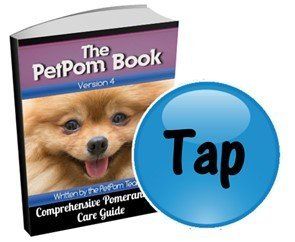Eating Problems
PetPom
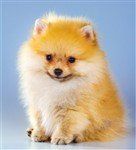
The
Pomeranian
Information
Center
Pomeranian Eating Problems
Overview
Whether you have a new Pomeranian puppy or you've had your older Pom for a while, inevitably issues with food and feeding will arise.
We've rounded up the most common questions that we receive from our readers and Members, and are answering them all here in one spot.
So, if your Pom has any type of odd quirk or things are not going swimmingly in regard to proper feeding, you will most likely find the answer here.
My Pomeranian Eats Too Fast
Why Poms do this:
There are a few different reasons why a Pom may eat too fast.
The dog may feel rushed. This is often the case if people are standing too close or if there is another pet right by the Pom or eating at the same time.
It may also be a simple matter of a dog being overly hungry.
In some cases, a Pom may just have a zest for his food, which is not a bad thing.
It your Pom loves his food so much that he just wants to gulp it all down consider yourself lucky.
There are a few different reasons why a Pom may eat too fast.
The dog may feel rushed. This is often the case if people are standing too close or if there is another pet right by the Pom or eating at the same time.
It may also be a simple matter of a dog being overly hungry. In some cases, a Pom may just have a zest for his food, which is not a bad thing; if your Pom loves his food so much that he just wants to gulp it all down consider yourself lucky.
What can happen:
Eating much too fast and literally gulping down food can cause problems. In particular, ingesting food at a very fast pace often causes a lot of air to be swallowed as well. This can cause abdominal cramping.
While it is very rare with toy breeds like the Pomeranian, theoretically it could cause bloat as well.
On an emotional level, feeling rushed to eat fast can be stressful for a dog. Meals should be an enjoyable event.
What to do:
1.
Create a more peaceful eating area. If you have more than one pet, keep their dishes in opposite corners of the room if possible. The area should also be free of foot traffic, lots of talking, etc. to help create a calm environment.
2. Be sure that your Pom is eating at least 2 meals per day, with 3 being optimal for many Poms. If you are away during the day, be sure to leave a mid-day meal for your Pom. Using a treat-release toy like PetSafe's Busy Buddy Barnacle Toy in Size Extra Small
 is a great method for this.
is a great method for this.
And the funnest new device that we've just discovered is a super neat treat-dispenser web-cam!
It is a bit pricey, but goodness it is blast (for both owner and dog) and if your Pom is home alone most days, this can be well worth it.
It holds treats and has a web-cam with 2-way audio. You can see your Pom in real-time on your phone, and speak to him. Then, you simply tap your phone and a treat shoots out. If you want to check it out, it is the Furbo Dog Camera: Treat Tossing, HD Wifi Cam, and 2-Way Audio .
.
3.
To help control the speed that a Pomeranian eats, add a portion pacer to the dish. Larger breeds can eat from slow-feeder bowls; however, most are sized much too big for Poms.
And if you find a small one, most likely it is made of plastic, which should be avoided (even those that are BPA free). Plastic bowls can cause a gradual fading of the nose.
So, using a portion pacer like the Omega Paw Small Portion Pacer
 is a great option.
is a great option.
My Pom Tries to Hide Food
Why Poms do this:
Taking bits of food and running off to hide them is a canine behavior called caching.
Typically, dogs do this if they feel as if their food is not safe, and this is common in multi-pet households.
(continued below)
-min-319x325-1920w.jpg)
-min-319x325-1920w.jpg)
Bambi, at 3 months old, photo courtesy of Lisy
What to do:
1.
Work to create a peaceful eating environment. If you have more than one pet, each should have their own designated eating area.
2.
It can help to create structure. Before each meal take your Pom for a walk, have him sit while you prepare his dinner, place the bowl down for a certain amount of time (usually 15 minutes is good), and then remove the bowl.
If need be, gate off the exit from the kitchen; but, do not stand guard since hovering too close can cause a dog to feel possessive of his food.
-min-263x325-1920w.jpg)
Louie, photo courtesy of Terry F.
My Pomeranian Only Eats Treats, Won't Eat Kibble
Why Poms do this:
This is a trap that owners fall into if they see that their Pom really enjoys treats. To keep the dog happy, treats are given out more and more often. Eventually, a point is reached where the Pom is eating so many snacks that there is no room left for meals.
This is a trap that owners fall into if they see that their Pom really enjoys treats. To keep the dog happy, treats are given out more and more often.
Eventually, a point is reached where the Pom is eating so many snacks that there is no room left for meals.
What to do:
As long as you know that the kibble you've chosen for your Pom's meals is a top-quality food that is well tolerated, this all comes down to an owner's will-power.
It is in your hands, and your Pom is simply following along.
As long as you know that the kibble you've chosen for your Pom's meals is a top-quality food that is well tolerated, this all comes down to an owner's will-power. It is in your hands, and your Pom is simply following along.
1.
Reserve treats as reward for good behavior, with no more than 5 or 6 small bites given out each day.
The best time to offer a treat is to reinforce potty training.
Even if a Pom is fully trained it's wise to keep showing him that you're happy rules are being followed.
2.
Be sure that the treats are very small, so that reward can be given without filling a Pom up. A good choice are Fruitables Crispy Bacon and Apple Crunchy Dog Treats
 and the other wonderful flavors in that line.
and the other wonderful flavors in that line.
3.
Prepare meals (of a top quality brand - more ahead), place the bowl down, and do not give in to expectations of treats. And this is where some owners cannot continue on.
The most common complaint is 'My Pom flatly refuses to eat his meals, so I'm forced to give him treats instead'. However, this is not what is happening. What is really occurring is that the Pom has learned that all he must do is wait long enough for his owner to cave in.
To canines, eating is survival. Dogs will not allow themselves to starve. So, if you stand firm, within a day you can teach your Pomeranian that he must eat his meal and that a treat will not be coming no matter what.
And as stated, he will receive his favorite snacks, but at appropriate times for reward.
My Pomeranian Only Eats Chicken and Rice
Why Poms do this:
This is another trap that owners can fall into. It commonly happens if a Pom is having an intolerance to commercial dog foods or was having a stomach issue in which the owner switched to a bland diet.
And those are indeed valid reasons for offering just chicken and rice.
But, this is meant to be temporary.
A problem can set in when a Pom really enjoys this type of meal and doesn't want to eat anything but that.
While both chicken and rice are healthy, this sort of very limited diet will quickly lead to nutritional deficiencies.
What to do:
There are two approaches that you can take. One is to add to that base to provide all that is needed and the other is to make a change to a top quality kibble.
(continued below)
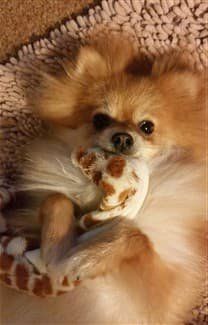
Small Fortune, photo courtesy of Kathy S.Parkersburg
1.
If you have decided that you want to stick with making homemade meals, there'll need to be quite a few additions. The good news is that most Pom do love these ingredients.
As touched on earlier with the problem of only eating treats, this will entail the owner standing firm. Once you prepare the meal, do not waver on this. Your Pom will indeed eat it if no other choice manifests (which is you giving in).
Additions should include vegetables; broccoli, green beans, peas, carrots, and sweet potato are good choices. And there should be some fruit; blueberries and raspberries are super healthy.
-min-325x244-1920w.jpg)
(continued below)
-min-325x244-1920w.jpg)
Smokie, photo courtesy of Eileen Bacon
A vitamin and mineral mix is added to commercial kibble, no matter how good the food. So, you will need to add a daily vitamin as well. You may find a powdered formula easiest and Everpup's Ultimate Daily Dog Supplement
 is a good choice.
is a good choice.
2.
If you have decided that you'd like your Pom to be eating a commercial kibble, you can initiate a change-over.
In most cases of a dog not reacting well to manufactured food, this is due to chemicals, by-products or other nasty ingredients found in inferior foods.
So, if that was a problem that you had in the past, if you choose a superior food that is all natural and has only wholesome ingredients, this should prevent future issues.
One of the top choices includes Wellness CORE Natural Dry Grain Free for Small Breeds
 which has zero additives, no soy, no corn, no wheat, no by-products, and is made in the USA.
which has zero additives, no soy, no corn, no wheat, no by-products, and is made in the USA.
My Pomeranian Only Eats if I Hand Feed Him
Why Poms do this:
This is the 3rd 'trap' that we've touched on already! This breed is a pro at manipulating their humans. But, who can blame them? If an owner spoils a Pom too much, that puppy or dog is not going to be the one to make a change.
This begins innocently by hand-feeding the Pom once in a while. Parenting instincts take over, we want our Pom to be happy... and then before you know it, it's become a habit and the Pom refuses to eat out of the bowl.
What can happen:
If a Pomeranian only eats when an owner hand feeds them, this can lead to problems. An owner may not always be able to be 'on call', which means that the Pom will not be on a proper feeding schedule.
Additionally, being pampered is nice but when it's done to this degree it prevents a dog from gaining important skills that lead to both independence and self-confidence.
What to do:
There are many things that we must do for our Pom's sake that are not necessary fun for them; but, it is in their best interest. And this is no exception.
Be sure that you have the right bowl for your Pom. It should be properly sized, at a comfortable height, and made of quality stainless-steel.
Set this up near the water dish in a quiet corner of the kitchen to create a pleasant dining area.
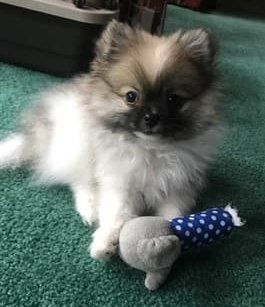
(continued below)
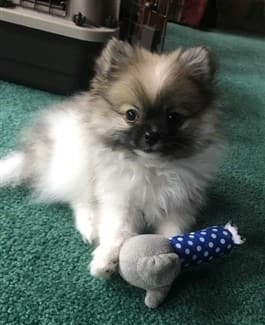
Mia Bella, photo courtesy of Patricia Roth
Mia Bella, at 3 months old, photo courtesy of Patricia Roth
Allow your Pom to see that you are making the meal and placing it down. Remember that your Pom does not actually refuse to eat other than from your hand; rather, he is refusing to eat from the bowl up until the time that you give in.
So, this is a matter of remaining firm, not hand-feeding, and allowing enough time to pass that your Pom realizes that the only way that he will have his meal is from his dish.
My Pomeranian Won't Eat Unless I'm in the Room
Why Poms do this:
This is another common issue and is closely linked to the above problem of hand-feeding.
(continued below)
List of Pomeranian Supplies
- Not sure what you should have? Read over a list of what's needed for optimal care, comfort, safety, and happiness.
This often becomes a habit when an owner hovers over their Pom to ensure that they are eating well and enjoying their meal. But, when done consistently, this can inadvertently teach a Pomeranian that his owner 'must' be there.
This is particularly true if the puppy or dog has a good understanding of proper hierarchy and sees their human as the Alpha.
What to do:
Just as the Pom was mistakenly taught that his owner needed to be in the same room for him to eat, he can be taught that he can eat independently.
It is often best to make this a gradual transition. Begin by standing several feet away than you normally do. If the dog refuses to eat, stand firm and do not walk closer. If there is a hold-out for more than 10 minutes, you may want to take the bowl away and try again 10 minutes after that.
The goal will be to move several feet away every few days. Once you reach the point of being able to be in another room, be sure to give lots of praise once the meal is eaten.
My Pom Won't Eat Dry Dog Food
Why Poms do this:
If a Pom only eats wet food, at some point there was an offering of this and due to having a preference of liking the texture more, the dog may turn his nose up at dry food.
What can happen:
There are two main concerns with this. In general - though there are exceptions - wet commercial food can cause runny stools. If this is happening, changes should be made.
The other concern is that dry food is good for a dog's teeth. And toy breeds like the Pomeranian are prone to tooth decay. So, if wet food is given, it is very important to be super strict with at-home dental care.
What to do:
1.
You may opt to stick to the wet food option, if it is a 4 or 5 star food, if it is not causing tummy woes, and if you are spot-on with dental care.
You'll want to regularly brush your Pom's teeth at home, and also offer a daily dental treat.
For the dental treat, be sure to choose one that has been awarded the Seal of Acceptance by the Veterinary Oral Health Council and is made in the USA. A good option is Greenies Teenie Dental Dog Treats .
.
2.
To make a switch to dry food, you can start mixing both dry and wet. Do a gradual change over the course of 3 to 4 weeks.
And you may find that your Pom does best with 3/4 dry to 1/4 wet and there is nothing wrong with this.
Just be sure that both are high quality brands.
My Pomeranian is Eating Non-Food Things
This covers quite a few elements, and we'll take this one by one.
(continued below)
-min-227x325-1920w.jpg)
Maxx and his new brother Beauxx, photo courtesy of Dr. Rocelle R. Maliksi
1. When a Pom eats grass, this is often a combination of both a lack of nutrients in his main meals and being given the opportunity to graze on grass.
2. When a Pom eats poop, this is often due to the same reasons as the grass-grazing; both his diet is lacking something (or has too many fillers which creates a false feeling of satiety), combined with opportunity.
3. When a Pom eats cat food, this is similar to the two issues above; however, there is an added element of cat food containing higher fat levels and the dog simply finding that it tastes better.
4.
Eating pebbles and other little things while being walked is not an uncommon eating problem, but it can certainly cause issues including gastrointestinal distress and even partial blockage, which is an emergency situation.
While it may seem too obvious, the answer to this is to not allow it. The key, however, is to have a safe way to control your Pom while you walk and be able to pull back on the leash without causing injury.
This can be done by using a harness instead of a collar, which is one of our most important care tips for Poms. This breed is prone to collapsed trachea, and a harness can help prevent this. And, while you are walking, you can reel your Pom in and/or pull him to you without putting any tension on the neck.
There are some great harness options that fit even tiny Poms like the BingPet Soft Mesh Adjustsable Harness Vest , which comes size XS and Small, and has 10 color options.
, which comes size XS and Small, and has 10 color options.
My Pom Won't Eat His Kibble
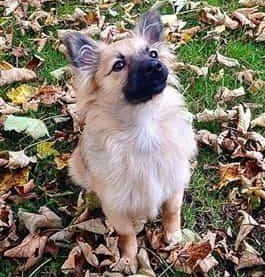
-min-265x325-1920w.jpg)
Mona, photo courtesy of Ciara & Becky
Mona, photo courtesy of Ciara Cinnamond and Becky Miskimmin
This can actually cover quite a few eating issues, so let's try to sort this out.
1.
If a Pomeranian won't eat his kibble due to being given too many treats, this was covered earlier under My Pomeranian Only Eats Treats.
2.
If a Pomeranian is not eating at all, and by this we mean literally, this points to a very serious health issue that requires immediate veterinary care.
3.
If a Pom is eating but does not appear to be eating enough, there are several reasons for this and is fully covered in a separate article that covers when a Pomeranian is not eating.
4.
If a Pomeranian is very finicky and doesn't appear to like anything that he's given, this is another matter that we'll discuss here in more detail ahead.
My Pomeranianis Picky About His Food
My Pomeranian is Picky About His Food
1. If you have tried a bunch of different dog foods and your Pom seems to hate all of them, there are 3 parts to this.
1-
This is a matter of needing to choose one that you know is a top, superior food and then leaving it at that. Picky Poms need a leader that will make a choice for them.
2-
Some Poms soak up the attention that they receive when their humans dot over them, hovering close by, and acting concerned.
3-
Keep in mind how much your Pom actually needs. Many owners pour too much food into the dish. Puppies only need about 1/4 to 1/2 cup per day. Adults only need about 1/2 to 3/4 cup per day.
So, by making a choice for your Pom, taking a stance that it is not up for debate, and measuring out the right amount, the issue will be resolved.
Note
that if a Pomeranian stops eating and loses weight
this goes beyond just being picky and requires a very direct intervention.
(continued below)
The Amazing Benefits of Having a Canine Playpen
You might be surprised to learn the ways in which the right playpen makes life easier for you and happier for your Pom.
My Pomeranian is Allergic to Chicken
Why this happens:
It should first be noted that in the case of food allergies, it is much more common for a dog to be allergic to a food additive than it is to have a reaction to an actual food.
Artificial coloring and flavoring and chemical preservatives are the top culprits. So, if you suspect that your Pomeranian may be allergic to chicken, you may want to first rule out that these additives are not the actual problem.
This said, dogs can indeed be allergic to chicken, turkey, duck, or other poultry proteins.
And, this is something that can develop as a dog matures, so it can happen at any age.
The signs of this will be the same as with other allergies.
It should first be noted that in the case of food allergies, it is much more common for a dog to be allergic to a food additive than it is to have a reaction to an actual food.
Artificial coloring and flavoring and chemical preservatives are the top culprits. So, if you suspect that your Pomeranian may be allergic to chicken, you may want to first rule out that these additives are not the actual problem.
This said, dogs can indeed be allergic to chicken, turkey, duck, or other poultry proteins. And, this is something that can develop as a dog matures, so it can happen at any age.
The signs of this will be the same as with other allergies.
This includes itchy skin, rash, poor coat quality, thinning hair, and/ or sore spots. There may also be some intestinal distress including upset stomach and/or vomiting.
What to do:
Or course, the obvious answer is to feed a kibble that contains no chicken. However, if you are conscientious about what your Pom eats, you'll notice that most of the top brands are chicken-based formulas.
So, the tricky part is to find a superior, top-rated brand that contains a different protein.
Fortunately, there are some great options. A top-line, quality formula is Merrick Lil Plates Grain-Free Small Breed Salmon Recipe, which is made specifically for small dogs.
Ingredients include salmon, sweet potatoes, peas, whitefish, coconut oil, apple, flaxseed oil, and blueberries. This is an all-natural food with no artificial additives, no by-products, no corn, no soy and no grains. It also has probiotics which aids in easy digestion. This is made in the USA.
Merrick also offers another chicken-free option: Merrick Lil Plates Grain-Free Small Breed Beef Recipe , which contains both beef and lamb. Other ingredients include sweet potatoes, peas, salmon, peas, flaxseed oil, apples, and blueberries.
, which contains both beef and lamb. Other ingredients include sweet potatoes, peas, salmon, peas, flaxseed oil, apples, and blueberries.
Does your Pomeranian have an eating issue that is not covered here?
Email us at Contact@PetPom.com, and we'll try to add it in.
You May Also Like:
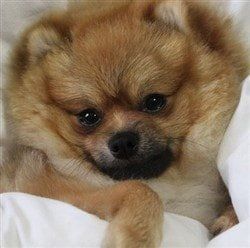
Separation Anxiety
This refers to the struggles that a puppy or dog can have when home alone and faced with feeling isolated and lonely.
This is not uncommon with dogs, and especially with breeds like the Pomeranian that were developed to be lap dog companions.
Fortunately, there are some steps you can take and methods you can use, that can combine to really help a Pom. Read more
about Pom Separation Anxiety.
If you email photos to us, you agree that PetPom is given free copyright to use at our discretion. We will always credit the photo to the name of the Pom's owner(s) if it is supplied.
Email: Contact@PetPom.com
All text, images and artwork protected by US and International copyright laws. All rights reserved. Copyright PetPom.com
We are a participant in the Amazon Services LLC Associates Program, an affiliate advertising program designed to provide a means for us to earn fees by linking to Amazon.com and affiliated sites.



